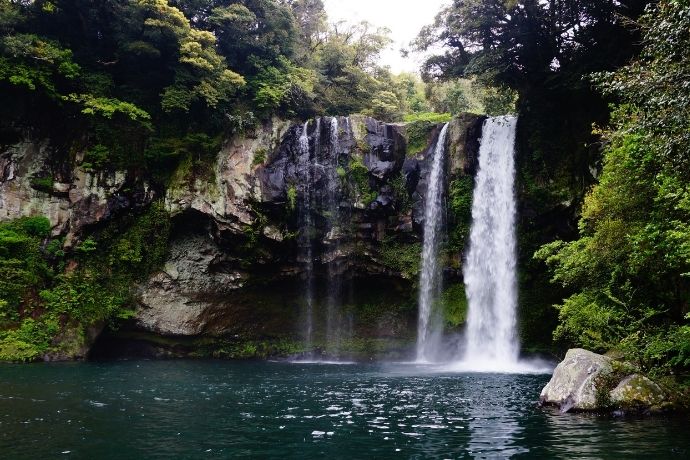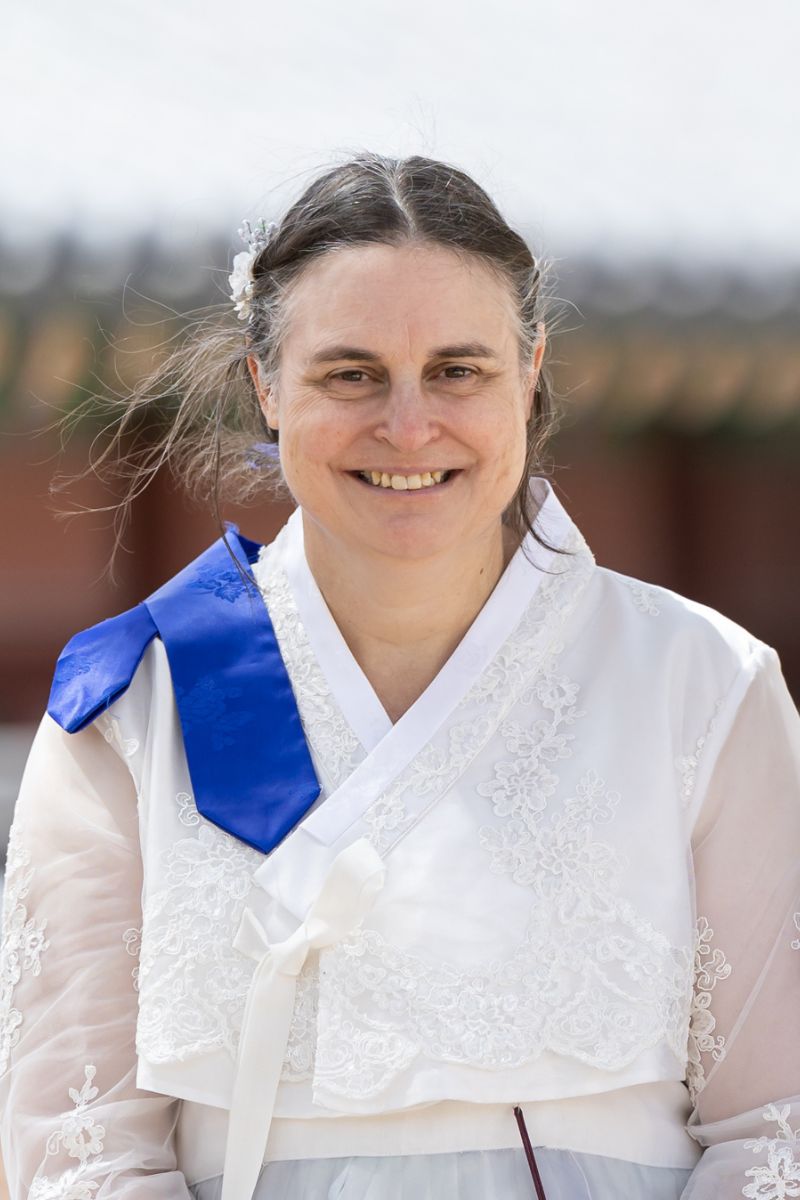A popular question for visitors is what are the best things to do on Jeju Island. The aim of this article is to help you learn more about the most popular attractions in Jeju Island for tourists to help you plan your visit.
Plan to stay for at least 3 days to make the most of your visit, and preferably longer if possible. Jeju Island is easy to get to from Seoul and other locations. Jeju Island Airport (Airport code CJU) is an International Airport, which means that many tourists can travel directly to Jeju Island from other countries as their first point of entry into South Korea.
There are also multiple options to catch a ferry to Jeju Island, from Seoul (Incheon), Busan, Mokpo, Nokdong or Yeosu. Many cruise lines also have the option to visit Jeju Island for a day.
Jeju Island is mostly easy to get around, either by renting a car, catching the local buses, booking into shared or private day tours or using the local taxis. Click here to check out our detailed article on how to get around Jeju Island.
In our experience you will get a lot more value out of taking a guided tour to learn more about each attraction that you visit. Therefore, as you go through our article below, we have also recommended coach, small group and private tour options, which will enable you to fully experience each attraction.
These tours can be easily booked through Klook, Trazy and Get Your Guide, who are our recommended online travel agents for South Korea. They have a good reputation and we have worked with each of them for many years now, so have high confidence that they will enable you to have a great experience!
Don’t miss out on the opportunity to make your trip planning easy, hassle-free and organized. Click here to download your FREE printable checklist, to help you to plan your trip step by step and tick off items as you finalise your preparations.Join the South Korea Travel Planning Facebook Group
You are also welcome to join our South Korea Travel Planning Facebook Group – it is a great resource to enable you to ask questions about your upcoming trip to South Korea!
Disclaimer: This article contains affiliate links. If you book after clicking on one of these links then we may receive a small commission at no extra cost to you.
About Jeju Island
Jeju Island is the largest island in South Korea and is located 90km / 56 mi south of Wando in the Korean Strait. Jeju Island has an oval shape, and measures 73km / 45 mi west to east and 31 km / 19 mi north to south. Hallasan Mountain is a dormant volcano which sits in the centre of the island and is the tallest mountain on the island with a height of 1947m (6,398 ft).
Jeju Island has a large range of different types of attractions as detailed below. When planning your visit to Jeju Island, ensure you also consider which activities you are interested in doing. If you plan to climb Mt Hallasan, ensure you check the weather to determine which day of your visit is best suited for this activity.
- UNESCO World Heritage Listed natural attractions, including Mt Hallasan, Manjanggul and Hallim Park Lava Tube Caves, Seongsan Ilchulbong (Sunrise Peak), Sangumburi Crater, Jeongbang Waterfall, Sejeongbang Waterfall, Cheonjiyeon Waterfall, Cheonjeyeon Waterfall, Daepo Jusangjeolli Cliff (hexagon basalt cliffs), Sanbangsan Mountain and the Yongmeori Coast.
- Korean Heritage attractions, including the Jeju Haenyeo Museum, the Women Diver Show at Seongsan, and Jeju Folk Village.
- Coastal attractions, including Hyeopjae Beach and Aewol Gwakji Gwamul Beach, other beaches and many other coastal rocks.
- Man made attractions (often kitschy!), including the O’Sulloc Tea Museum, Ma Horse Theme Park, Aqua Planet Aquarium, Glass Castle, Jeju Aerospace Museum, World Automobile Museum, Maze Land, Jeju Rail Park, Love Land and many more.
- Resort and adventure activities such as fishing, surfing, stand-up paddle boarding, yachting, horse riding, paragliding, scuba diving, jet boating, hang gliding and many more options.
Tourist Map of Jeju Island
To help you better understand where each tourist attraction is located on Jeju Island, we have put together an overview map below, including southern departure ports. We have also put together separate detailed maps for each region of Jeju Island lower in this article. You can click on these maps to see additional detail without leaving this page.
The major tourist centres on Jeju Island are:
- Jeju City is located in the centre of the north side of Jeju Island. Jeju International Airport, Domestic and International Ferry terminals are all located in Jeju City.
- Seogwipo, in the centre of the south side of Jeju Island
- Mt Hallasan, the dormant volcano in the centre of Jeju Island
- Seongsan is located on the east side of Jeju Island
- Udo Island is located on the east side of Jeju Island, and can be accessed by ferry from Seongsan.
- Hyeopjae Beach is located on the west side of Jeju Island
Major Events on Jeju Island
The major events on Jeju Island each year include the following (note many events were cancelled due to COVID19 and are currently in the process of being re-established). There are many smaller festivals on Jeju Island throughout the year, check them out here.
- Seongsan Sunrise Festival over 31 December – 2 January each year
- Jeju Fire Festival – Feb/Mar
- Jeju Cherry Blossom Festival – early April
- Jeju Haenyeo Festival – October
Jeju Island Tours
When you check out the Jeju Island attractions below, note that there are also several well priced tour options to help you visit. Check out our detailed article on Jeju Island Tours for more information. Below is our summary of recommended tour options for Jeju Island.
Jeju Island UNESCO Small Group Day Tour
- Book this tour for one or two days to do two different routes with an English speaking guide. All admission fees are included.
- See all of the major Jeju UNESCO listed attractions, and also hike a short trail on Mt Hallasan on the South Course (Viator East and South course links)
- Jeju East Route on Tue/Thu/Sat and Jeju South Route on Mon/Wed/Fri
- Pick up and drop off from your Jeju City Hotel
- Book this 9 hour private tour for up to 10 people with an English speaking driver
- Pick up and drop off from your Jeju City Hotel
- Recommended routes, however you can customise your itinerary to suit your interests.
- Book this tour for multiple days to make the most of your Jeju Island visit!
- Admission fees, food and drinks not included, need to pay for drivers lunch
- Costs from $US 246 (for 2 people, cheaper per vehicle prices for larger groups)
- Book this Jeju Island Package Tour for either 2,3, 4 or 5 nights, which includes your hotel accommodation in Jeju City and return flights from Seoul for groups of up to 4 people (per person price reduces for larger groups)
- Choose either Flight plus Hotel only or All Inclusive (which includes a one day 8 hour private tour)
- Costs from $US 174, price gets cheaper for larger groups. Can add on other tour options for longer stays.
Jeju Island UNESCO & Must-Visit Attractions Coach Day Tour
- Book this tour for up to four days to do four different routes with an English speaking guide. All admission fees are included.
- See a combination of UNESCO Listed attractions and other fun attractions.
- West Jeju Route A and East Jeju Route A on Mon/Wed/Fri
- West Jeju Route B and East Jeju Route B on Tue/Thurs/Sat
- Pick up and drop off from your Jeju City Hotel
Things to Do in Jeju City
There are many things to do in Jeju City as detailed below.
Dongmun Traditional Market
Dongmun Traditional Market is the largest permanent market on Jeju Island, and is also the oldest market on the island, having been established in 1945. The market combines a traditional market, street market, seafood market and night market. There are many great options for tourists to both shop and eat. Jeju Island specialities include Black Pork, seafood and tangerines. Market hours are 7am – 8pm for the regular market, and 6pm-midnight for the night market.
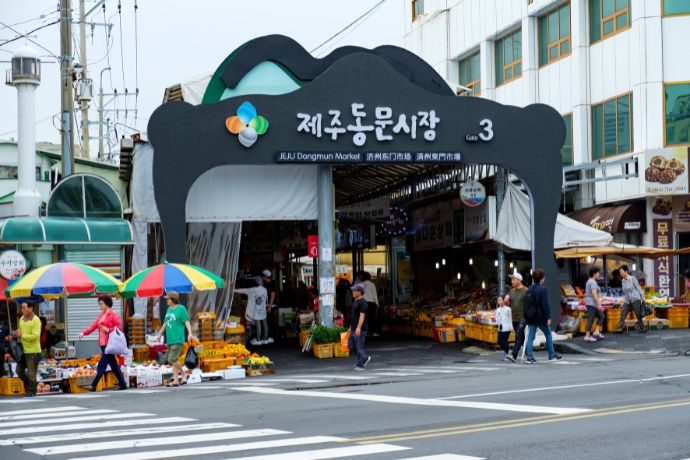
Black Pork Street
Black Pork Street is located on Chilseong Rd, north from Dongmun Traditional Market, and is a great place to try the famed local Black Pork. There are also other Black Pork restaurants in Jeju City which have great reputations, check out Sukseongdo, Donsadon, Heukdonga, Childonga or Delicious Black Pork. Some of these are located near Jeju Airport and be aware that you may need to wait in a queue.
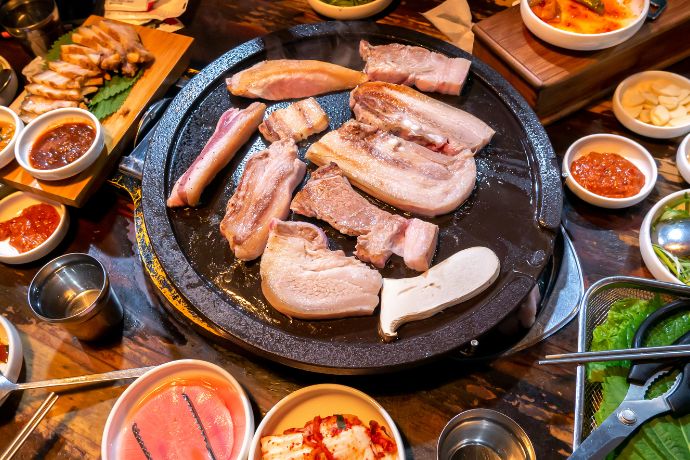
Jeju Folklore and Natural History Museum
Jeju Folklore and Natural History Museum is a great option to learn more about Jeju Island. Exhibits include geology, marine history and the cultural history of the Jeju Island people. Plan about one hour to visit this museum. Opening hours are 8.30am – 6.30pm, and in summer from 8.30am – 7pm.
Samseonghyeol Shrine
Samseonghyeol Shrine is located behind the Jeju Folklore and Natural History Museum, and is the location of a Jeju Island legend about the origin of Jeju Island. Three demi-gods first appeared in this location, who became the founding fathers of Tamna (the old name for Jeju Island). The three holes are surrounded by ancient trees. Allow 30 minutes to visit the shrine. Opening hours are 9am – 6pm, with later opening at 10am on public holidays.
Sarabong Peak
Sarabong Peak is a 143m / 470 ft high volcanic cone located on the east side of Jeju City. From the peak, you can see amazing views of the ocean in the north and Mt Hallasan to the south. It is a popular location to view the sunset. It is open all year round.
Sanjideungdae Lighthouse
Sanjideungdae Lighthouse is located halfway up Sarabong Peak, and overlooks Jeju port.
Gwadeokjeong Pavilion or Hall
Gwadeokjeong Pavilion or Hall is located close to Jeju Port, and is one of the oldest buildings on Jeju Island. It was built in 1448 and was used to train soldiers. Plan 30 minutes to visit. Opening hours are 9am – 6pm.
Tapdong Street and Square
Tapdong Street and Square is the major foreshore tourist street in Jeju City, running along the foreshore from Jeju Port. The Tapdong Beach Stage is a popular outdoor performance area. Tapdong Street is also part of the Jeju Olle Route 17 walking trail.
Yongyeon Suspension Bridge
Yongyeon Suspension Bridge is located on the north side of Jeju City and provides excellent views of the Yongyeon Valley and pond and also the river exit to the sea. Yongyeon Bridge is a very popular location to view the beautiful scenery at night.

Yongduam (Dragon Head Rock)
Yongduam (Dragon Head Rock) is a 10m high rock which looks like a dragon’s head. Yongduam Rock is located 200m from the Yongyeon Suspension Bridge and is a very popular place to view the sunset. There are also cafes, bars and restaurants clustered around the area.
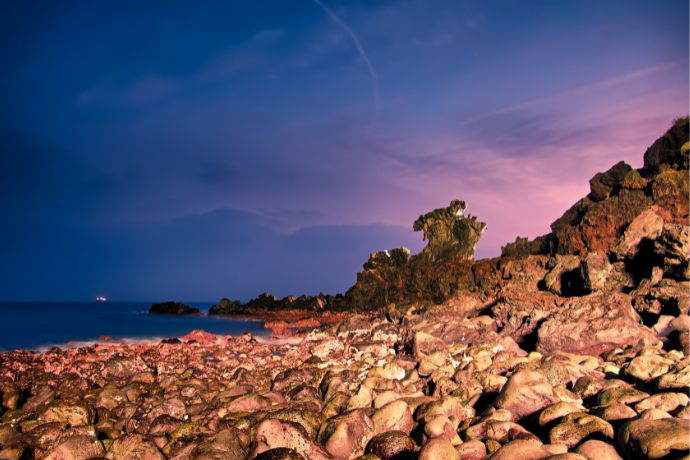
Eoyeong Coastal Road
Eoyeong Coastal Road is located north from Jeju Airport, and is a coastal walk which is part of the Jeju Olle Route 17 walking trail.
Dodubong Peak
Dodubong Peak is a 65m / 213ft high volcanic cone where you can take in views over Jeju Airport and City, as well as sea views.
Iho Tewoo Beach
Iho Tewoo Beach is a sandy beach located north from Jeju Airport and is famous for its two horse-shaped lighthouses. Iho Tewoo Beach is the closest swimming beach to Jeju City, and is a popular location for swimming, fishing, watersports, hiking and camping.
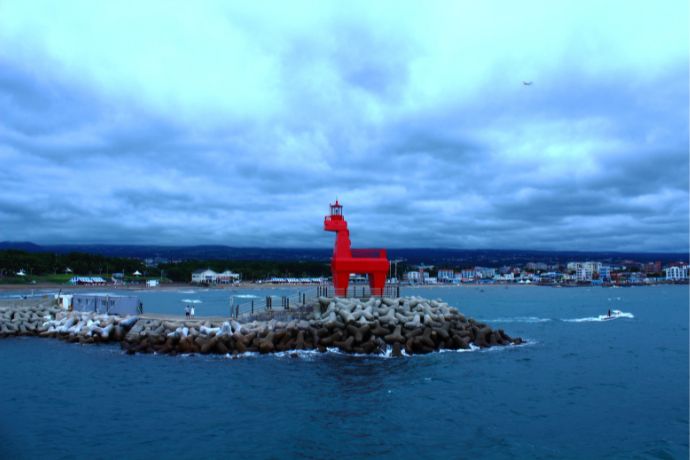
Jeju Minsok Traditional Five Day Market
Jeju Minsok Traditional Five Day Market is located south west from Jeju Airport and is the largest five day market on Jeju Island. It has over 1,000 stalls and has a wide variety of stalls ranging from fresh produce, clothing, fortune telling, plants and more. The market operates on any date which ends with a 2 or a 7, so it is open for six days each month. Opening hours are from 6am – 8pm.
Halla Arboretum
Halla Arboretum is located to the south of Jeju City, and is a great option to walk through a forest and explore its many garden areas. Halla Arboretum has over 100,000 plants on display, including over 1,000 rare species. Major displays include a glasshouse and orchid exhibition. Plan 1-2 hours to explore. Opening hours are from 9am – 6pm daily, and it is closed on some public holidays.
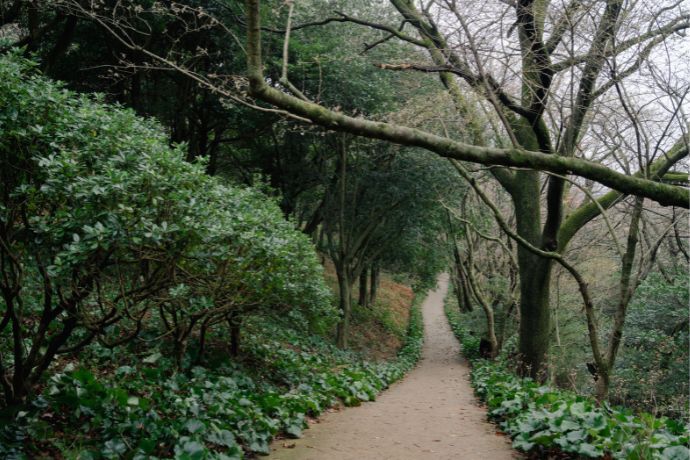
Jeju City Map
Below is a detailed map showing you the locations of attraction in Jeju City.
How to Use the Jeju City Tour Bus
Jeju City is easy to get around using the Jeju City Tour Bus, which operates daily from 9am to 7pm. To do the full loop takes two hours. This is a great option to get to your hotel (if it is located on the loop), drop off your luggage and then easily explore Jeju City. You can book your Jeju City Hop On Hop Off Bus tickets through Trazy.
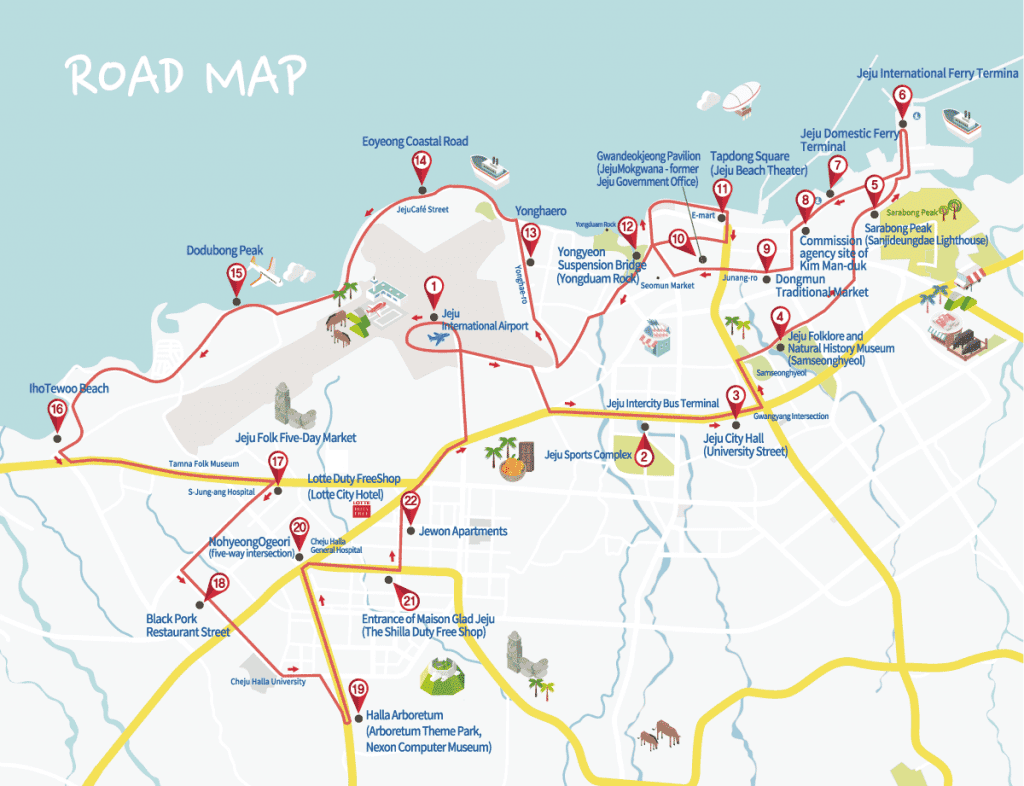
Hiking Hallasan
Hallasan National Park contains Mt Hallasan, the dormant volcano in the centre of Jeju Island. Mt Hallasan is the highest mountain in South Korea with a height of 1947m (6,398 ft). Hiking Hallasan is a popular activity, with a good variety of hiking trail options ranging from easy to difficult. The best time to plan to hike Mt Hallasan is from April to October each year. A summary of the hiking trail options is detailed below.
- The Hallasan Summit Trail is rated as a hard hike, is 17.1km / 10.6 mi long and takes approximately 7.5-8.5 hours. You hike up the Seongpanak Trail and then down the Gwaneumsa Trail or in reverse. Alternatively you can hike up and return on either trail. Note you need to start early, as if you have not reached the second shelter by 12.30pm you will not be permitted to complete the hike to the summit. You need a free permit to do this hike which is available at this link.
- The Yeongsil Trail is rated as a moderate hike, is 7.6km return and takes approximately 3 hours return. No permit is required.
- The Hallasan Witse-oreum Trail is rated as a moderate hike, is 11.1km one way and takes approximately 4.5 hours. You hike up the Yeongsil Trail and descend via the Eorimok Trail. You must start no later that 12 noon and start your descent by 2pm. This trail is open year round. No permit is required.
- The Eorimok Trail is rated as an easy hike, is 6.8km return and takes approximately 3 hours. No permit is required. The trail head is located in the north west section of Hallasan National Park.
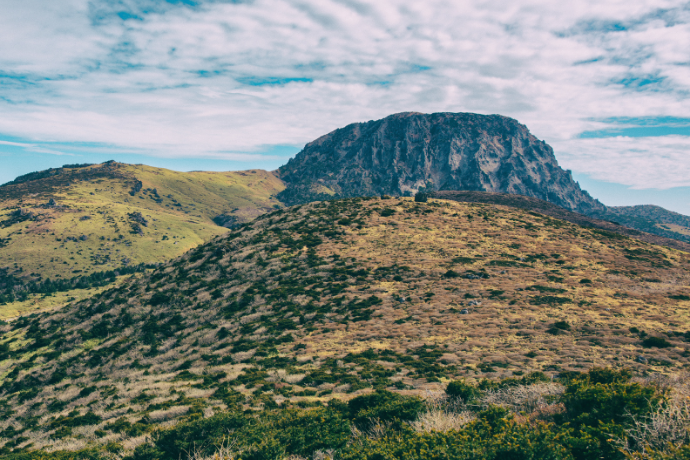
Hallasan Hiking Map
Below is a map showing the location of the trail heads for each trail. For more information about each trail check out the information on the AllTrails website.
Jeju Olle Trail
The Jeju Olle Trail is a 437km walking trail around the coastline of Jeju Island, including some offshore islands. The trail has been divided into 27 numbered sections which go clockwise around the island (although you can walk in either direction), so you can choose to walk specific sections to suit your interests. Each trail section is designed to take one day and is easily accessible by public transport, and there are accommodation options at the start and finishing points for each route.
The best time of year to walk the Jeju Olle Trail is generally from late March to mid-May, and then from mid-September to mid-October, to avoid the heat of summer and the cold of winter.
The most popular routes are as follows:
- Route 1. Siheung – Gwangchigi Olle. This is a 15.1 km / 9.4 mi long, 4-5 hour route on the eastern Jeju coastline which includes a visit to Seongsan Ilchulbong (Sunrise Peak).
- Route 6. Soesokkak – Jeju Olle Tourist Center Olle. This is an 11km / 6.8 mi, 3-4 hour route on the southern Jeju coastline which finishes in Seogwipo township.
- Route 7. Jeju Olle Tourist Center – Wolpyeong Olle. This is a 17.6km / 11 mi, 5-6 hour route on the southern Jeju coastline.
- Route 18. Old Downtown of Jeju-si – Jocheon Olle. This is a 19.8 km / 12.3 mi, 6-7 hour route on the norther Jeju coastline, starting from Jeju City.
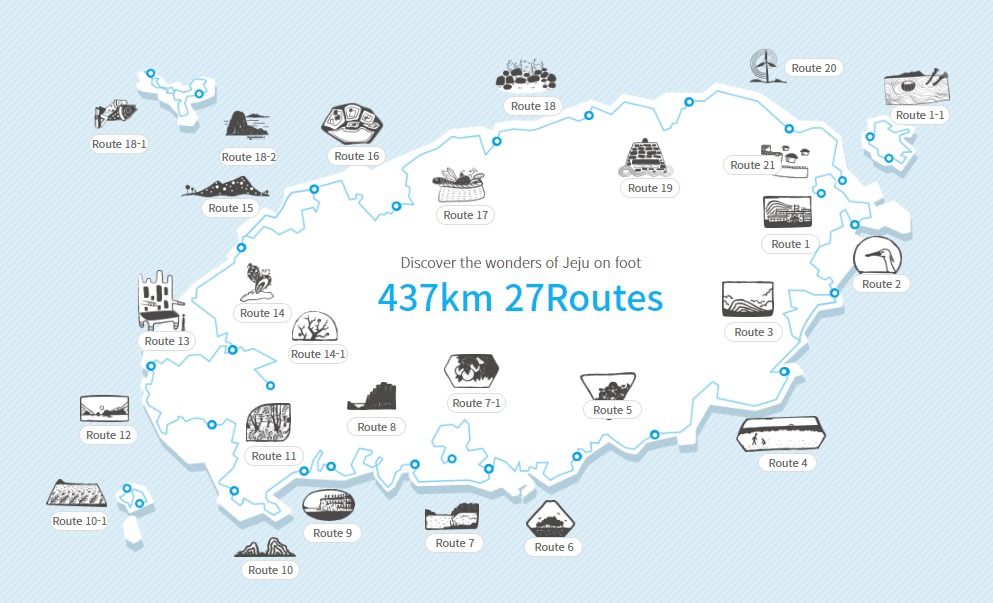
East Jeju Island Tourist Spots
The eastern side of Jeju Island has many attractions, so below is an overview to help you better understand the options and plan your visit.
Samyang Black Sand Beach
Samyang Black Sand Beach is unique in having black sand, compared with the white sand on most other Jeju Island beaches. Samyang Black Sand Beach is a popular location for swimming, surfing, sailing, and sand bathing. it is less well known to tourists so is often a less busy beach to visit.

Hamdeok Beach
Hamdeok Beach is a very popular swimming beach, with beautiful white sand, calm waters and great views. There are three separate beach areas, with Seoubong Mountain located to provide shelter from the wind. There is also a variety of watersports available along with many other amenities.

Bukchon Dol Hareubang Park
Bukchon Dol Hareubang Park is a great option to see the ‘Old Grandfather’ statues, called Dol Hareubang, which can be seen all over Jeju Island. In this park, you can see 48 examples of the statues and learn more about their history. Plan 1 hour to explore. Opening hours are from 9am – 6pm in April to October and 9am – 7pm in November to March.
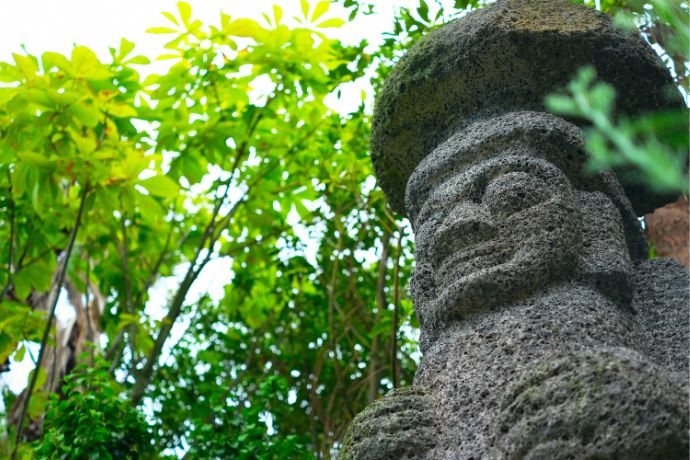
Manjanggul Lava Tube Cave
Manjanggul Lava Tube Cave is one of the longest lava tube caves in the world and was formed over 100,000 years ago. The length of the cave is 7.4km / 4.6 mi, however, only 1km / 0.6 mi is open for tourists to explore. The largest section of the cave is massive, with a height of 25m / 82 ft and a width of 18m / 60 ft. Inside the cave, you can see many formations, including lava columns, lava shelves, stalactites and stalagmites. Plan 1 hour to explore. Opening hours are from 9am – 6pm, and it is closed on the first Wednesday of each month. Bring your own torch or headlamp, and also wear walking shoes and a warm outer layer of clothing as the cave can be quite cold.
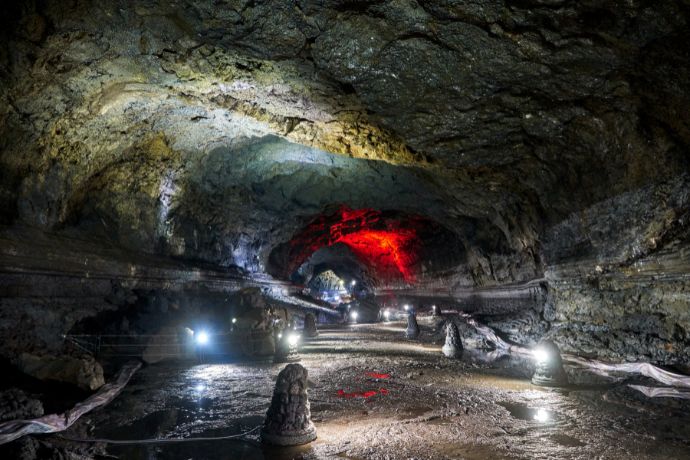
Woljeongri Beach
Woljeongri Beach is a very popular swimming and surfing beach, with beautiful white sand and great views. There is also a variety of watersports available along with many other amenities.
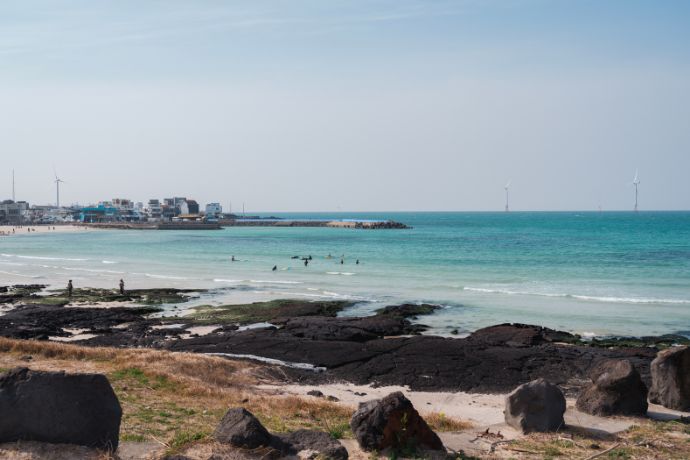
Jeju Haenyeo Museum
Jeju Haenyeo Museum provides information about the local Haenyeo female divers who since the 1600s and earlier have gathered seafood without using any underwater diving equipment. In 2016 the Jeju Haenyeo were inscribed as a UNESCO Intangible Cultural Heritage, and they can still be seen diving in many locations around Jeju Island. The Jeju Haenyeo Museum provides information about the life and history of the Jeju Haenyeo divers. Plan 1 hour to explore. Opening hours are from 9am – 5pm daily, and it is closed on some public holidays.
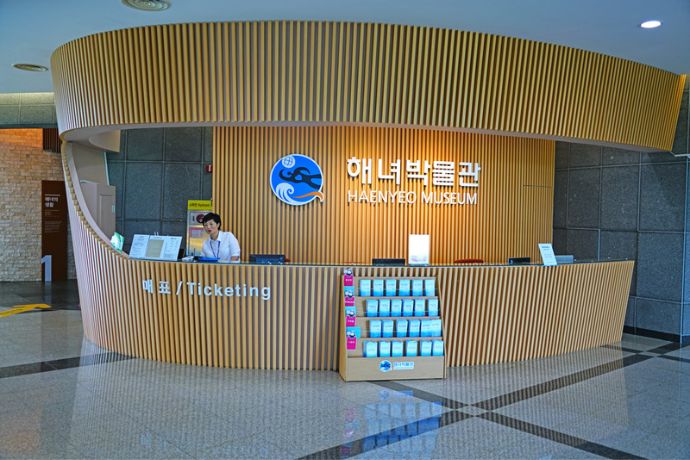
Seongsan Ilchulbong (Sunrise Peak)
Seongsan Ilchulbong (Sunrise Peak) is one of the most well known attractions on Jeju Island. The 180m / 600 ft high crater was formed as an underwater eruption around 5,000 years ago and was recognised as a UNESCO World Natural Heritage site in 2007. It is famous for being a wonderful location to view the sunrise. You can access Seongsan Ilchulbong one hour prior to sunrise to make the 20 minute climb to the peak, and you can also make the climb during the daytime. It is also a very popular location to see in the New Year, with a festival. Plan 1 hour to make the climb, explore and then return. Opening hours are from 1 hour prior to sunrise – 6pm daily.

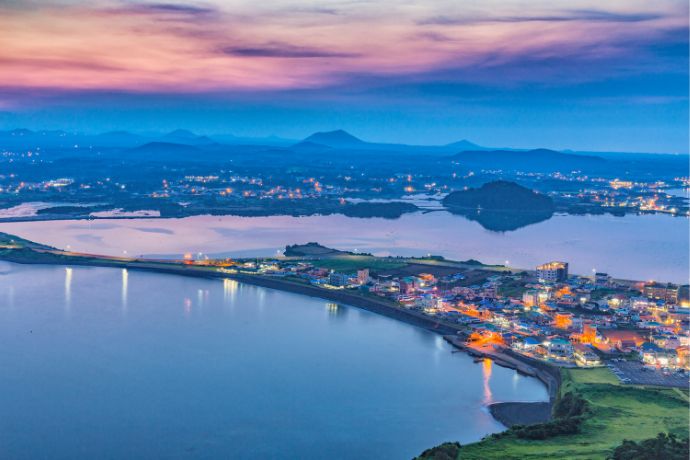
The Haenyeo Women Diver Show
The Haenyeo Women Diver Show is a great option to learn more about the Haenyeo Women Diver traditions and how they collect seafood. The one hour show occurs at Seongsan at 1.30pm and 3pm daily.
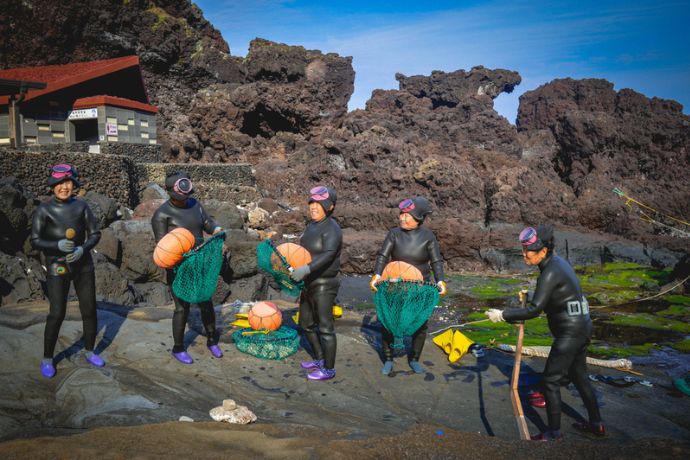
Udo Island
Udo Island (or Cow Island) is a tiny island located offshore from Seongsan. A regular ferry runs from Seongsan Port to Udo Island and returns approximately every 30 minutes during the daytime, ensure you check the departure time of the final ferry to ensure you do not miss it! You can get around Udo Island using the hop-on hop-off shuttle bus, hiring a bicycle, walking or renting a scooter. On Udo Island, the attractions include sea caves, views, the climb up the central peak called Udobong Peak (132m / 430 ft high), boat rides, beaches (check out Sanhosa Beach for a great experience) and peanut ice cream. Plan to spend the whole day on Udo Island to make the most of your visit.
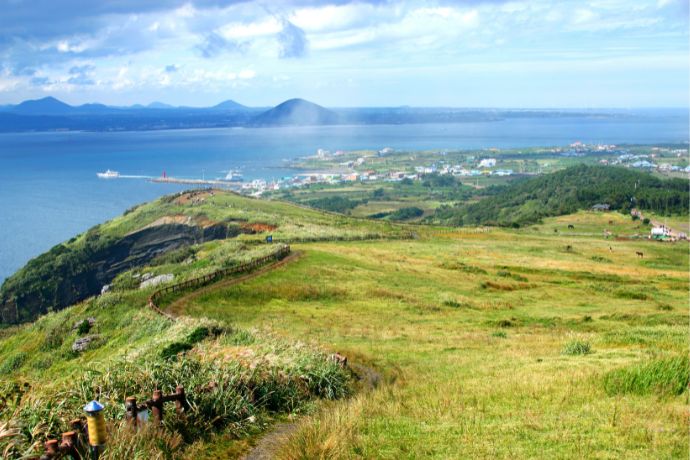
Seopjikoji
Seopjikoji is a cape which sits south of Seongsan Ilchulbong, where you can see lovely coastal views of the area. It is a relatively flat area, with green fields which bloom with bright yellow canola flowers in the spring. Bulgeunoreum Volcanic Cone is the highest point on the island, with a white lighthouse on top. Close by, you can visit the ancient beacon fire station, which was used to signal enemy attacks. Another great place to visit is the Glass House Restaurant and Observation Deck, especially when viewing sunrise and sunset – there is a great view of Seongsan Ilchulbong from the observation deck.
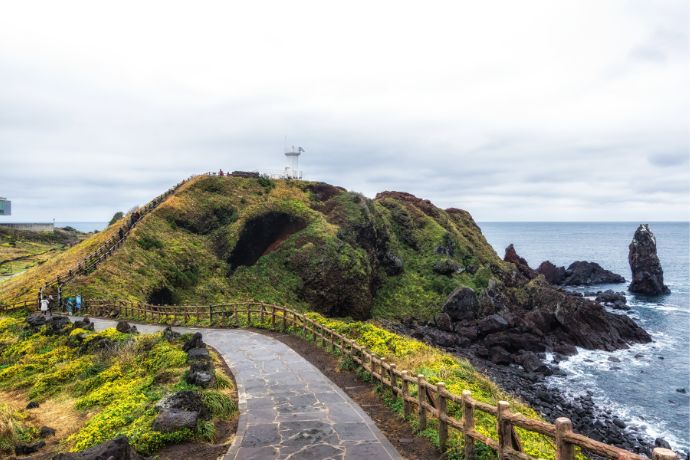
Aqua Planet Aquarium
Aqua Planet Aquarium is located on Seopjikoji, and is the largest aquarium in Asia, with over 48,000 animals and plants on display. The aquarium includes a focus on the underwater sea life of Jeju Island, a Submarine Tunnel, a large touch pool, plus amazing shows in the Ocean Arena, including a Haenyeo Diver display (typically held 4 times per day) and an underwater musical. Ensure you check what times the performances are on when planning your visit to ensure you do not miss out. Plan to take 3-4 hours to visit. Opening hours are from 9.30am – 7pm. Click here to book your Aqua Planet Aquarium and Ocean Arena Performance Tickets through Klook.
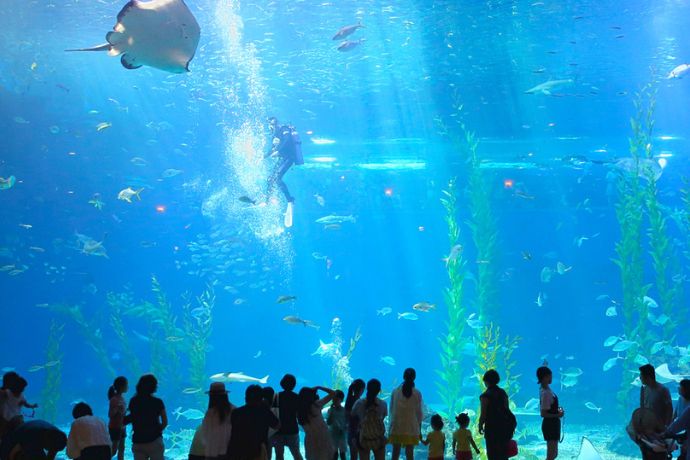
Jeju Folk Village
Jeju Folk Village is a great option to learn more about the history of Jeju Island. Onsite there are over 100 houses and community facilities which have been reconstructed from the 1890s. There are four main sections to explore, including the Mountain Village, Hill Country Village, Fishing Village and Shamanism Village and a great option is to rent a traditional hanbok to wear while exploring! You can take part in traditional crafts including pottery and wood carving and also in traditional games. Folk performances are typically held three times per day. Plan to take approximately 2 hours to explore. Opening hours are typically 8.30am to 6 or 7pm on weekdays only. Click here to book your discounted Jeju Folk Village Ticket through Trazy.
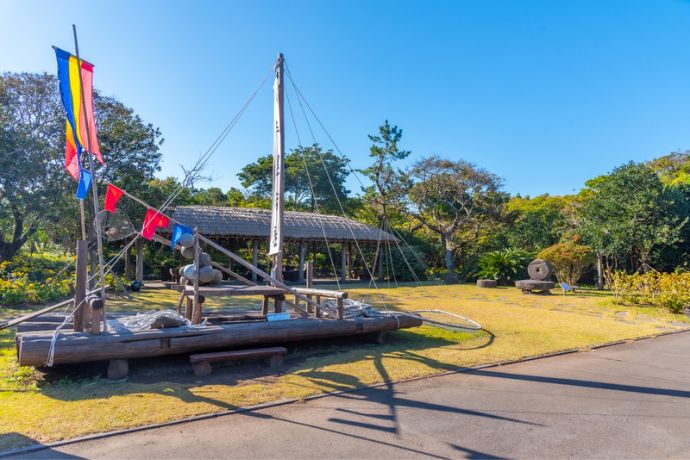
Pyoseon Haebichi Beach
Pyoseon Haebichi Beach is a very popular swimming beach beside Jeju Folk Village, with beautiful fine white sand and great views. It is popular on New Years Day to view the sunrise. There are excellent amenities nearby.
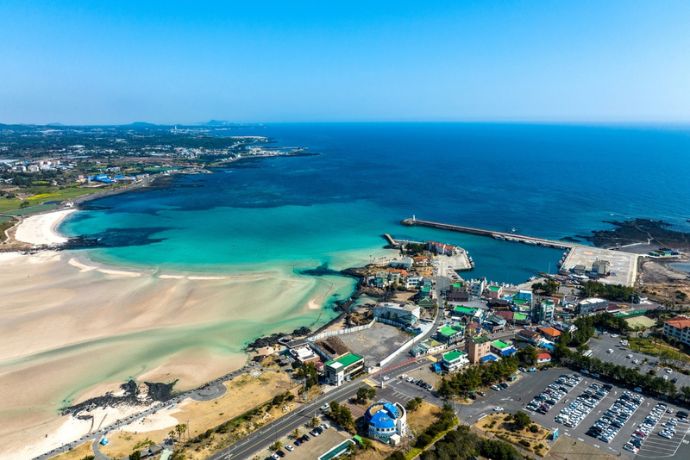
The Snoopy Garden
The Snoopy Garden is a cute themed garden where you can explore and relax. There are indoor exhibits, including a museum about the history of the Peanuts comic strip, as well as a large garden area to explore and take many photos with Snoopy characters! Plan to take approximately 2 hours to explore. Opening hours are 9am – 6pm from October to February and 9am – 7pm from March to September.
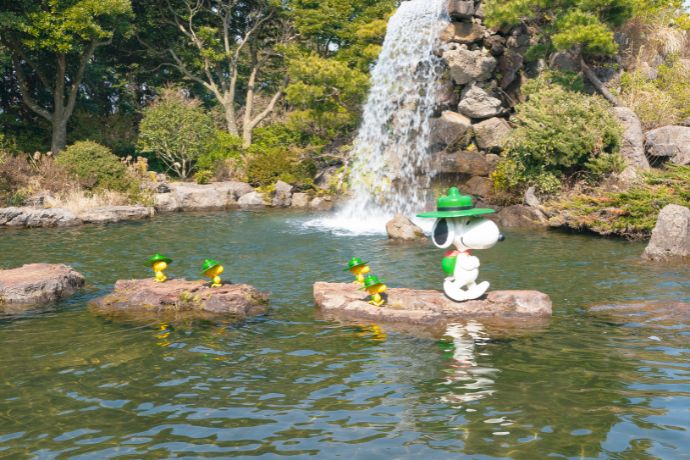
Seongeup Folk Village
Seongeup Folk Village is located at the foot of Mt Hallasan and is home to a Joseon Era (1400s) village with many authentic thatched roof houses and community buildings dating from that era. People still live in the village and act as guides to the village. You can walk through the village in around 30 minutes.
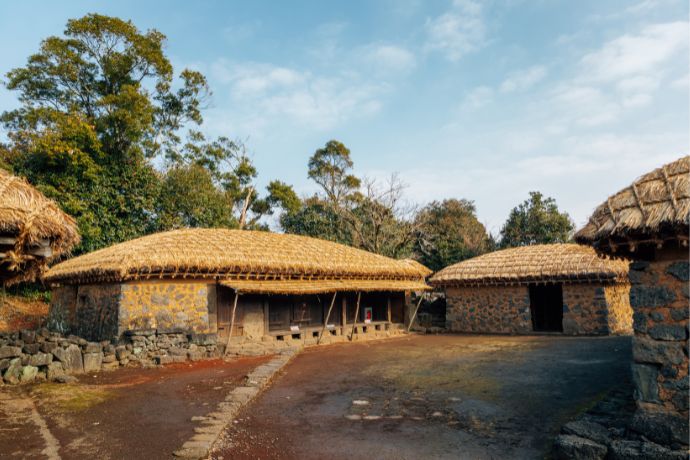
Sangumburi Crater
Sangumburi Crater is a flat crater which is like a massive hole in the ground where a lot of volcanic material was ejected. Inside, the crater is approximately 130m / 430 ft tall and with an internal diameter of 240m / 790 ft. In autumn the surrounding ridges are covered with beautiful silvergrass. Inside the crater, there are over 400 species of rare plants. Plan to take approximately 1 hour to explore. Opening hours are 9am – 5.40pm from November to February and 9am – 6.40pm from March to October.
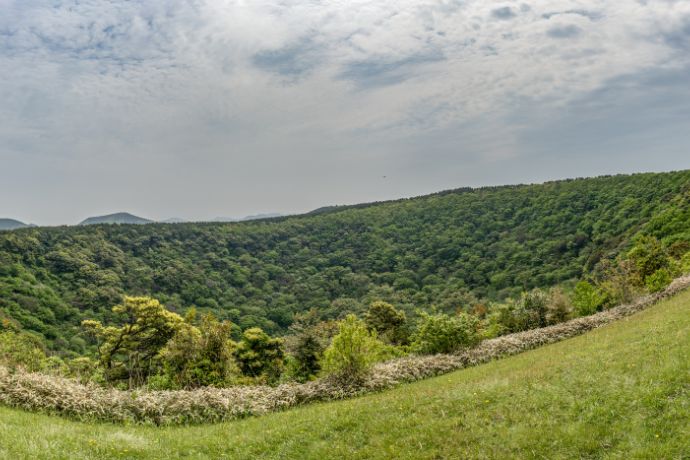
Jeju Stone Park
Jeju Stone Park is a large park where you can explore to see 48 Dol Hareubang statues and other traditional stonework. An indoor exhibition hall is also on site. Plan to take approximately 1 hour to explore. Opening hours are 9am – 6 pm. The park is closed on Mondays and some public holidays.
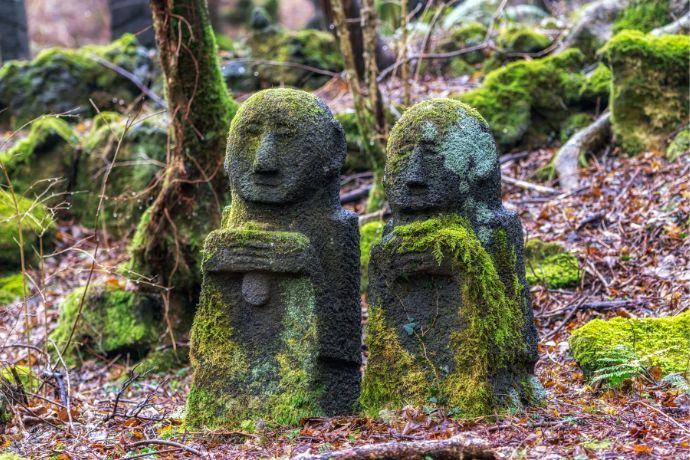
Maze Land
Maze Land is a great fun activity option with three mazes to explore as well as a maze museum. Plan to take approximately 1 hour to explore. Opening hours are 9am – 5.30pm with an extra 30-60 minutes in busier periods. Click here to book your discounted Maze Land tickets through Trazy.
East Jeju Island Map
Below is a map showing the location of the major attractions on the eastern side of Jeju Island.
Things to do in Seogwipo
Seogwipo is the second largest city on Jeju Island and is located centrally on the southern coast of Jeju Island. Seogwipo is quite unique in having three waterfalls close to the city centre, great markets and many other fun things to see and do. Things to do in Seogwipo include the following.
Seopwipo Olle Market
Seopwipo Olle Market is the largest market in Seogwipo and combines a traditional market, street market, seafood market and night market. There are many great options for tourists to both shop and eat. Jeju Island specialities include Black Pork, seafood and tangerines. Market hours are 7am – 8pm in winter and 7am – 9pm in summer.
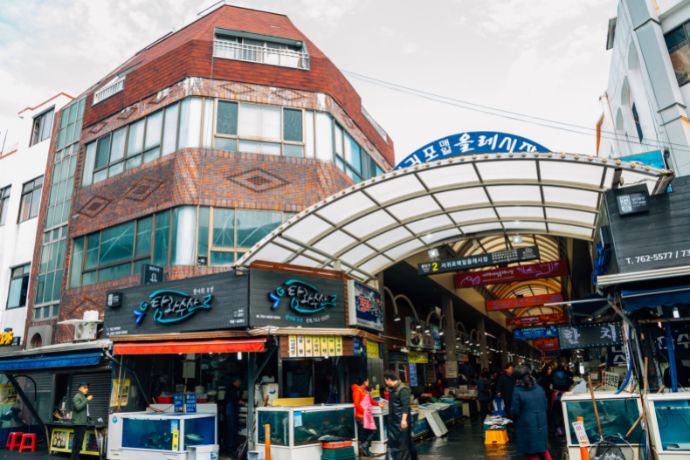
Lee Jung Seob Art Museum and Culture Street
The Lee Jung Seob Art Museum and Culture Street is across the road on the eastern side of the Seogwipo Olle Market, and as you walk southwards you can enjoy exploring the local cafes, restaurants and art galleries, and you can also see the view of the coastline.
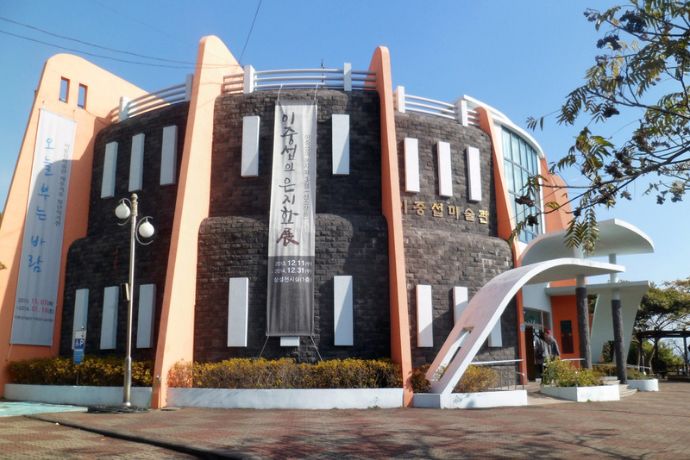
Seogwipo Tourist Port
Seogwipo Tourist Port is a short walk down Soldongsan Culture Street, where you can walk along the foreshore to see many art installations.
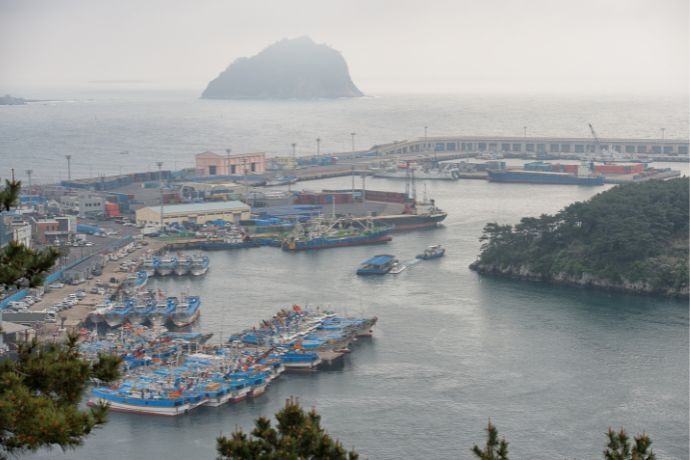
Jeongbang Falls
Jeongbang Falls is the only place in South Korea where a waterfall cascades directly into the sea. Jeongbang Falls is 23m high down a black rock cliff and is located at the eastern end of the Seogwipo foreshore area. Plan to take approximately 30 minutes to explore. Opening hours are 7.30am – 7pm in summer and 7.30am – 5.30pm in winter.
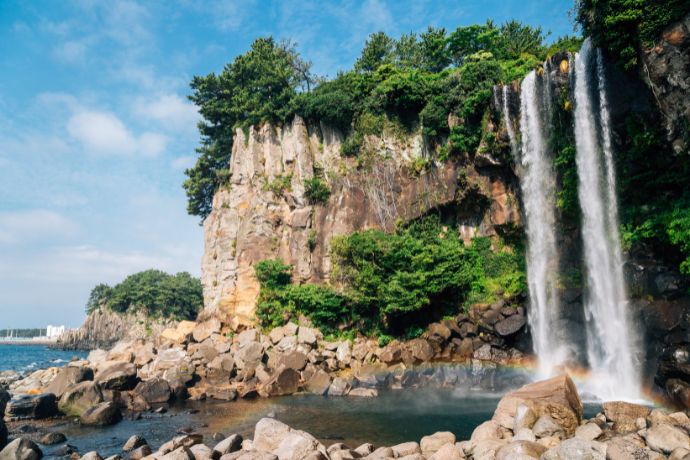
Sojeongbang Falls
Sojeongbang Falls is a smaller 5m high waterfall located 300m east of Jeongbang Falls, with ten streams below exiting into the ocean. It is open all year round.
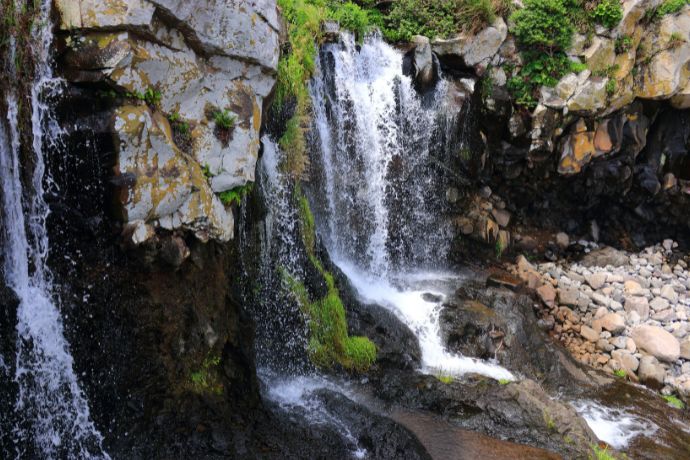
Saeseom Island
Saeseom Island is connected to the mainland via the sailboat-themed Saeyeongyo Bridge. It is a great option for a pleasant coastal walk. Allow 30 minutes to explore. It is open all year round.
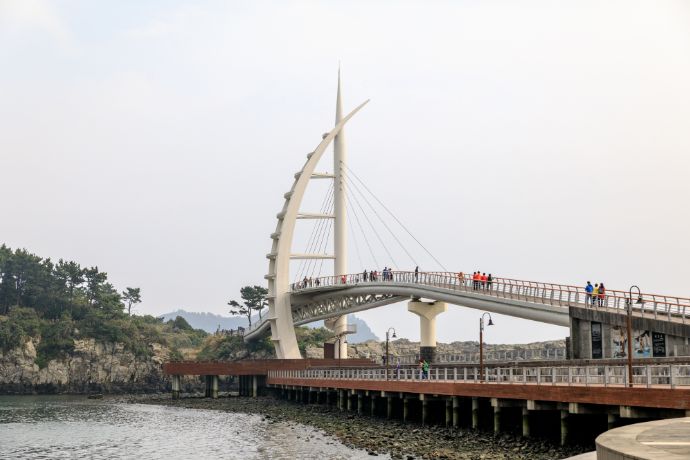
Cheonjiyeon Falls
Cheonjiyeon Falls is a 22m high waterfall located in the centre of Seogwipo, which is also illuminated at night time. Plan to take approximately 30 minutes to explore. Opening hours are 9am – 10pm.
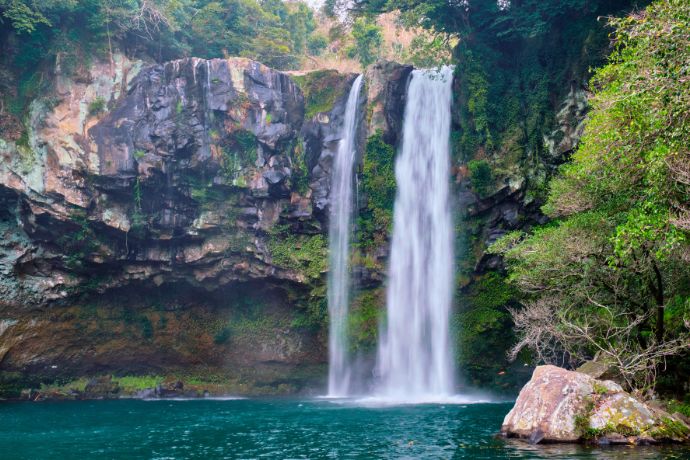
Oedolgae Rock
Oedolgae Rock is a 20m high freestanding stack on the coastline close to Seogwipo. It is estimated to have formed around 1.5 million years ago. Plan to take approximately 30 minutes to explore. It is open all year round.
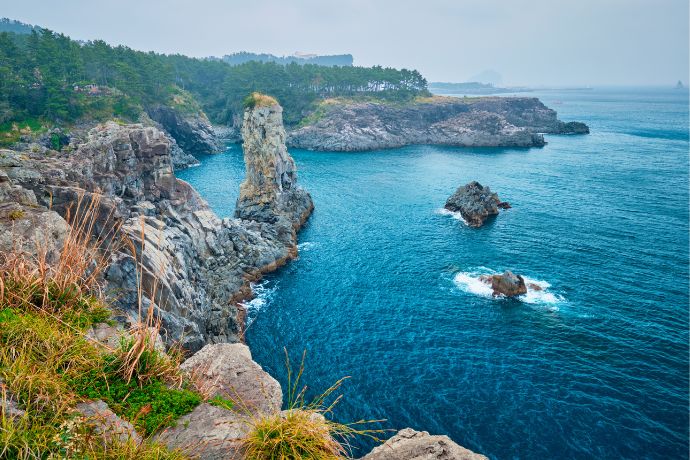
Seonnyeotang Rock Pools
Seonnyeotang is a group of natural rock pools where you can swim or snorkel and is also a location where you can view Oedolgae Rock. It is open all year round.
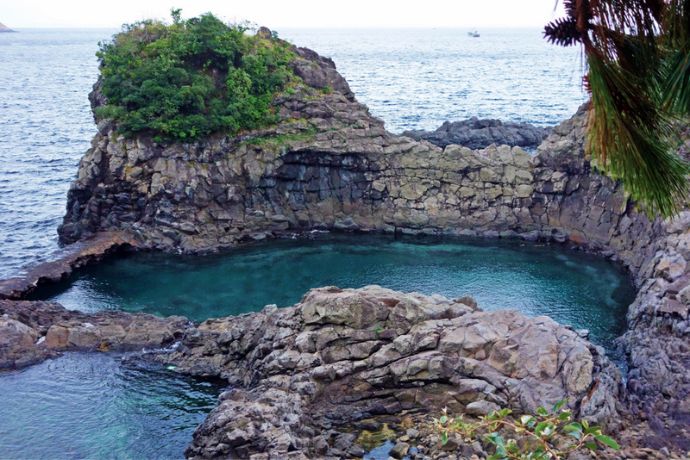
Seogwipo Hyangto Five Day Market
Seogwipo Hyangto Five Day Market is located north east of central Seogwipo. It has over 500 stalls and has a wide variety of stalls ranging from fresh produce, clothing, fortune telling, plants and more. The market operates on any date which ends with a 4 or a 9, so it is open for six days each month. Opening hours are from 6am – 6pm.
Seogwipo Map
Below is a map showing the location of the major attractions in Seogwipo.
South Jeju Island Tourist Spots
The southern side of Jeju Island has many attractions, so below is an overview to help you better understand the options and plan your visit.
Soessokkak Estuary
Soessokkak Estuary is a great option for exploring the still-water estuary. You can either kayak or take other water transport such as water bikes to explore the beautiful Swesoggak River. Where the river meets the sea, you can also enjoy exploring Hahyo Soesokkak Beach, which is a black sandy beach suitable for swimming and surfing. Plan at least 2 hours to explore the area.

Cheonjeyeon Falls
Cheonjeyeon Falls, also known as ‘The Pond of God’ is a three-tier waterfall which is the largest waterfall on Jeju Island. The top tier is easily accessible, however, accessing the other two tiers requires more walking down the many steps. The top tier is 22m / 72 ft high and falls into Cheonjeyeon Pond – note that water only flows over the top tier after heavy rain.
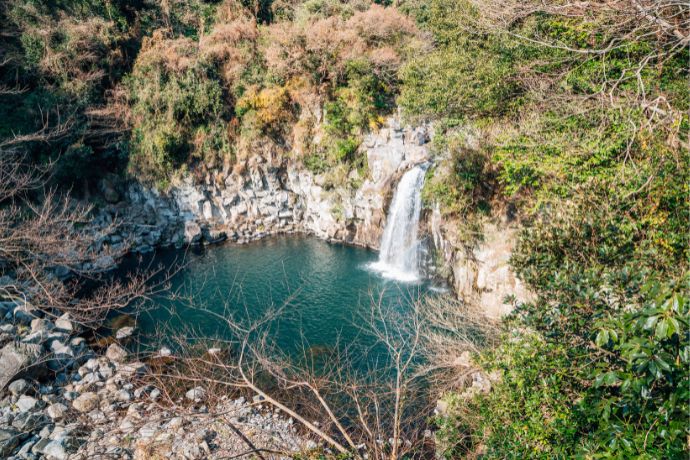
The middle tier is 30m high, after crossing the beautiful Seonimgyo Bridge (which links Cheonjeyeon with the Jungmun Tourist Complex) you can then view the lowest waterfall tier flowing into the ocean. The total walk to see all three tiers is a 1.6km loop trail, which should take around 30 minutes. Swimming is not permitted. Opening hours are from 9am – 5.30pm.
The falls are beside the Jungmun Tourism Complex, which is a large international resort which includes multiple hotels and other activities.

Jungmun Saekdal Beach
Jungmun Saekdal Beach is a 500m long white sand beach which is a great option for swimming and surfing. Other beach sports are also available, along with many watersports including yachting, kayaking, windsurfing, parasailing, water skiing, scuba diving and more.
The beach is part of the Jungmun Tourism Complex, which is a large international resort which includes multiple hotels and other activities.
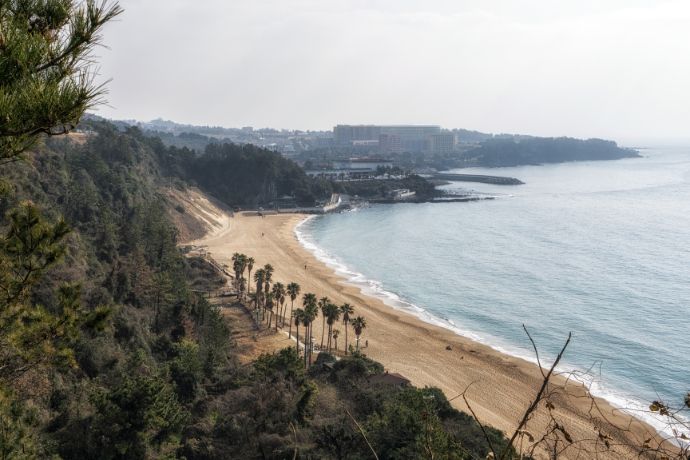
Teddy Bear Museum
The Teddy Bear Museum is a great indoor activity with two galleries featuring old and unique teddy bears on display to tell stories, recreate historical and famous scenes, reinterpret famous historical art, including animatronics displays. Plan at least 1 hour to explore the area. Opening hours are from 9am – 7pm, and 9am – 10pm in summer.
The museum is part of the Jungmun Tourism Complex, which is a large international resort which includes multiple hotels and other activities.
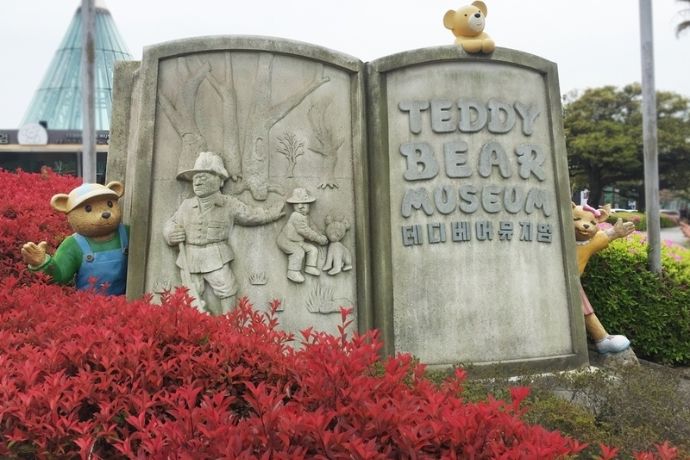
Chocolate Land
Chocolate Land is a great indoor option to learn more about chocolate in the World Chocolate Exhibition Hall and also make your own chocolates.
Chocolate Land is part of the Jungmun Tourism Complex, which is a large international resort which includes multiple hotels and other activities.
Yeomiji Botanical Garden
Yeomiji Botanical Garden is located close to Cheonjeyeon Falls and is one of the best botanic gardens in Asia. The massive indoor garden includes a 38m high observation tower and many exhibits, including a Flower Garden, Aquatic Garden, Cactus Garden, Jungle Garden, Mystery Garden and a Tropical Fruits Garden. Outdoor there is a 24 acre garden with Korean, Japanese, French, Italian, Lawn, Herb and Bog Gardens to explore. Plan to take approximately 1.5 hours to explore. Opening hours are from 9am – 6pm.
The gardens are part of the Jungmun Tourism Complex, which is a large international resort which includes multiple hotels and other activities.
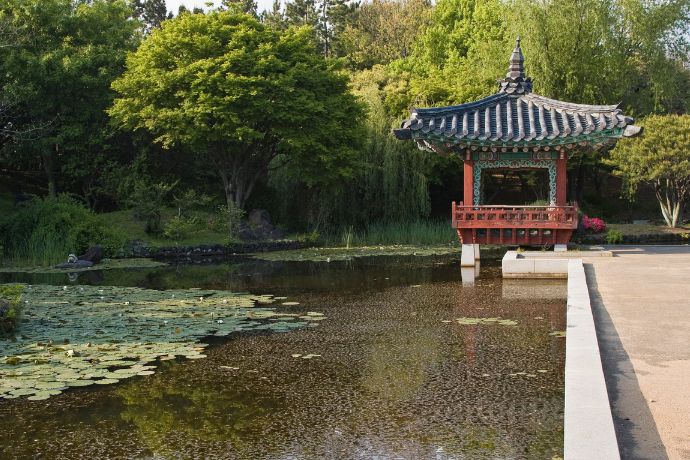
Jusangjeolli Cliff
Jusangjeolli Cliff is a spectacular 20m high black basalt cliff formed as a result of lava flows from Mt Hallasan. The lava flows cooled into adjoining hexagonal shaped stone pillars, which have been eroded over time to form the amazing cliffs. The views are best when waves crash into the cliffs. You can easily view Jusangjeolli Cliff from the cliff top park. Plan to take approximately 30 minutes to explore. Opening hours are from 9am – 6pm.
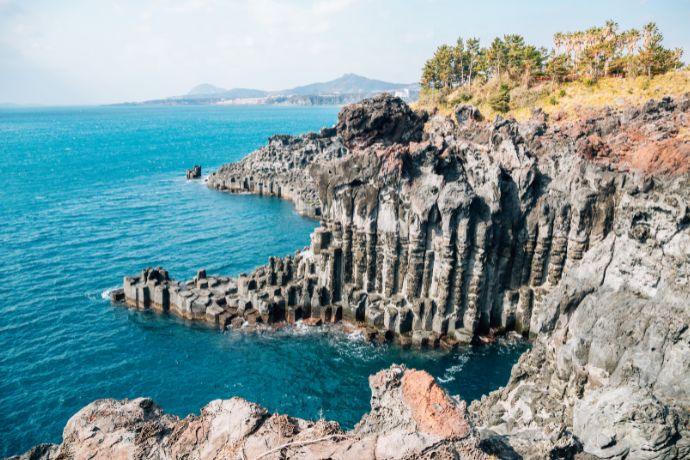
Sanbangsan Mountain
Sanbangsan Mountain is a distinctive 395m / 1295 ft high lava dome on the Yongmeori Coast which was formed 700,000 to 800,000 years ago. There are many locations where you can view Sanbangsan Mountain in the area, as it is the dominant feature. Canola fields near the mountain have bright yellow flowers in spring which make a memorable backdrop to the mountain.
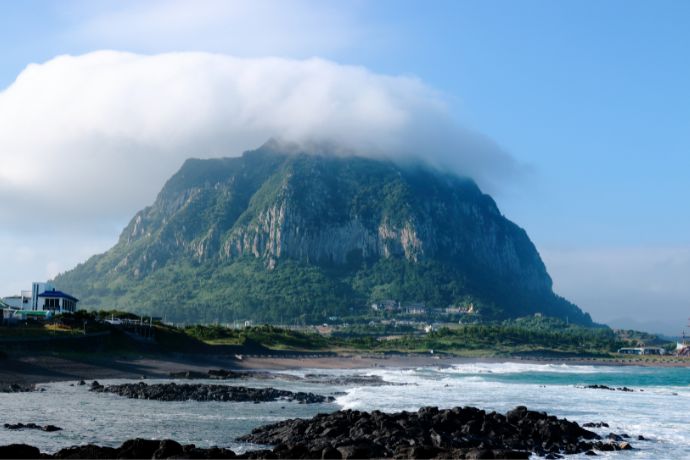
Steps enable you to climb Sanbangsan Mountain. At 150m above sea level, you will find the Sanbanggulsa Grotto or Cave Temple. Inside the large cave, you will find an immense statue of Buddha, as well as amazing views of the coastline. This cave is where monk Hye-Il (~964-1053) lived during the Goryeo Dynasty. You can then visit Bomunsa Temple to see their large golden Buddha statue, along with a large collection of smaller Buddha statues. Note that clouds regularly cling to the summit. Plan to take approximately 1-2 hours to explore. Opening hours are from 8.30am – 6pm.
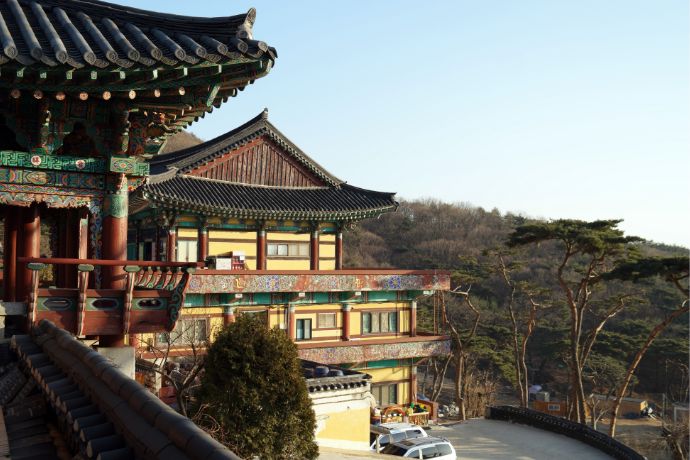
Yongmeori Beach
At Yongmeori Beach, Sanbangsan Mountain stretches into the ocean. The beach is named due to it looking like a dragon head going underwater. The beach has spectacular stacked 20m high black sandstone cliffs all along the beach area which have been sculpted by waves and wind.
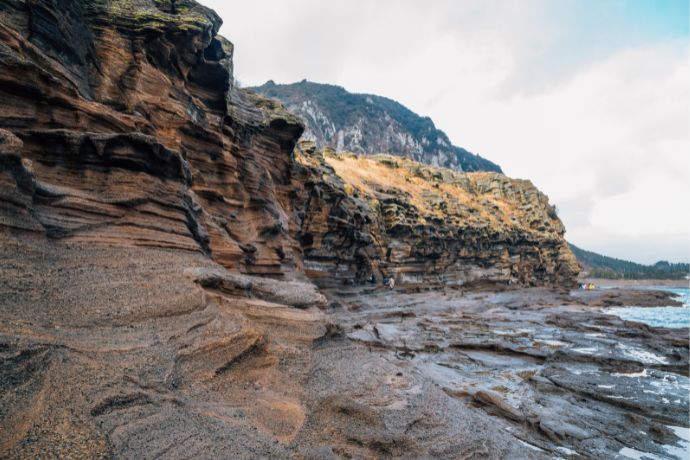
There are two entry options to climb down to the beach level. First is the steep Cave Trench which was dug by the Japanese military in World War II. The second option at the other end of the 700m cliff side walk. You can then walk the 700m long path to explore the beach area. Along the way several groups of Haenyeo Divers regularly sell fresh caught seafood (cash only). Plan to take approximately 1-2 hours to explore. Opening hours are from 9am – 5pm, however note the beach is shut at high tide or in dangerous weather conditions.
Hwasun Golden Sand Beach
Hwasun Golden Sand Beach is close to Sangbangsan Mountain and is a popular swimming with beautiful white sand and great views.
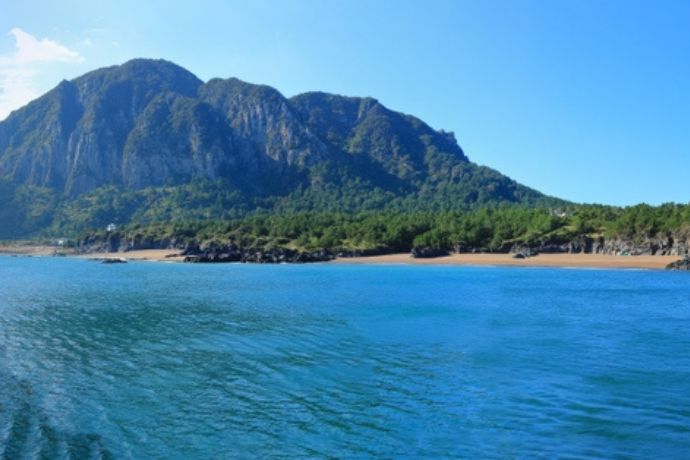
Sagye Beach
Sagye Beach is a lovely quieter beach with views of Sangbangsan Mountain, Songaksan Mountain, Hallasan and Brother Island off the coast. Sagye Beach is very popular for surfing and kitesurfing, however is rough for swimming.
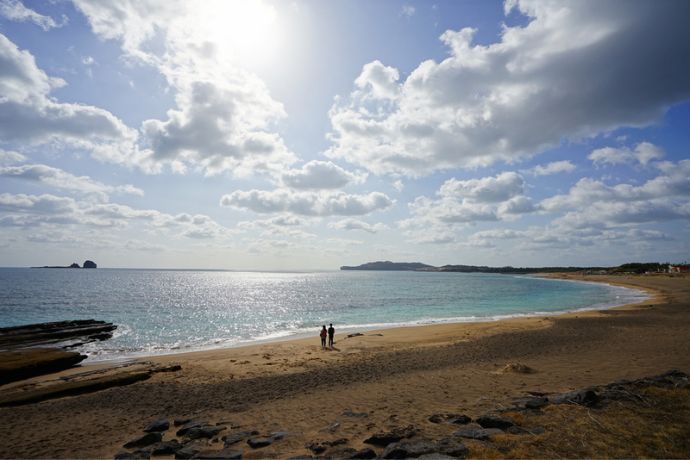
Seogwipo Forest of Healing
The Seogwipo Forest of Healing is a lovely forest located inland from Seogwipo with 11km of quiet walking paths, with 10 themed pathways to explore ranging from 2km / 1.2 mi and longer. Visitors must make reservations to enter the trails.
Onsite are forest healing programs for various groups which are led by an instructor with a maximum of 10 attendees. Programs include Forest Healing for Families, Forest Healing for Workers and Forest Healing for Adults to heal your mind and body.
Phone registration is the only option for international visitors on +82 64 760 30678 for both the healing programs and to book to visit the trails. Plan to visit for half a day to make the most of the experience. Opening hours are from 8am – 6pm from April to December, and from 9am – 5pm from November to March.
South Jeju Island Map
Below is a map showing the location of the major attractions on the southern side of Jeju Island.
West Jeju Island Tourist Spots
The western side of Jeju Island has many attractions, so below is an overview to help you better understand the options and plan your visit.
Hyeopjae Beach
Hyeopjae Beach is one of the most well known beaches on Jeju Island. Hyeopjae Beach has clear water, a 200m stretch of white sand which is contrasted with black lava rocks, shallow water and a lovely view of Biyangdo Island. During peak season Hyeopjae Beach is also open at night. There are many nearby amenities.
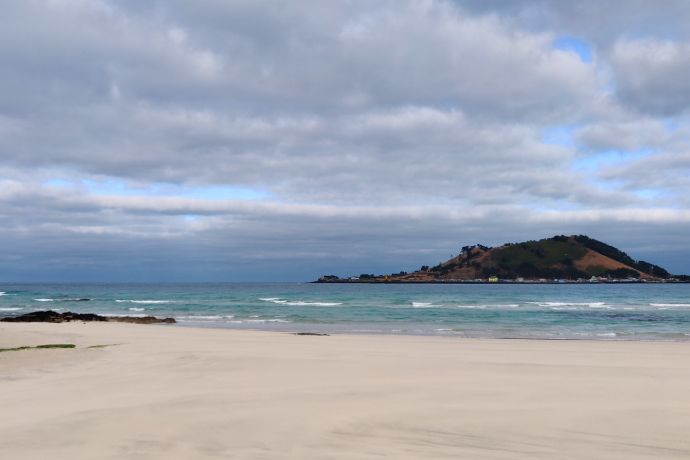
Geumneung Beach
Geumneung Beach is located on the southern side of Hyeopjae Beach, and is another top rated beach on Jeju Island. Geumneung Beach has soft white sand and shallow clear water, and views of Biyando Island offshore. It is a great option as it does not get as crowded as Hyeopjae Beach, and there is a larger swimming area. Activities include swimming, surfing, kayaking and more.
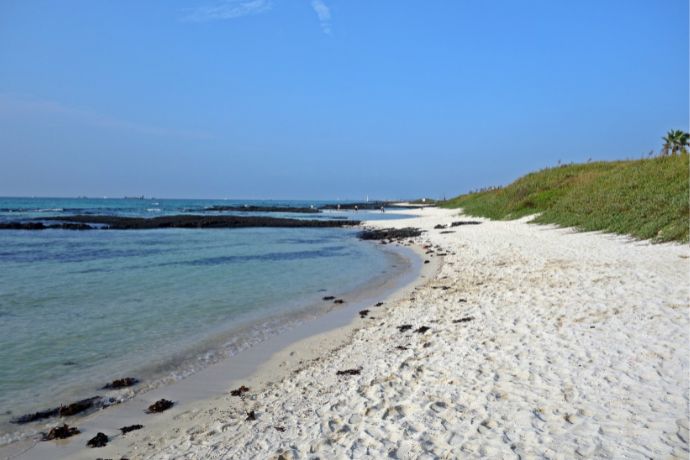
Gwakji Gwamul Beach
Gwakji Gwamul Beach is another top rated beach on Jeju Island, with a large sandy beach and clear water. A fresh water spring is located on the southern end of the beach where you can rinse off in the gender-separated Yongcheonsu Nocheontang bath house, either with or without your swimmers.
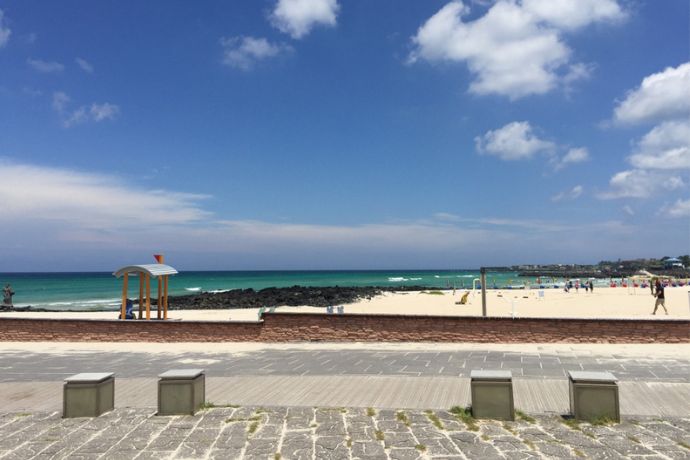
Hallim Park
Hallim Park is a large 80 acre garden opposite from Hyeopjae Beach and Geumneung Beach which has been built to incorporate Hyeopjaegul and Ssangyonggul Lava Caves alongside the many garden areas. Some of the most popular garden areas include the Stone Garden, Bonsai Garden and Jea-am Folk Village.
Hyeopjaegul and Ssangyonggul Lava Caves are believed to have been created as a result of an eruption of Mt Hallasan around 25 million years ago, and are believed to have been below sea level at the time due to the presence of fossilised abalone shells and other seashells. A 500m / 1640 ft length (approximately 3m / 10 ft high and 6m / 20 ft wide) of the caves is accessible to tourists at the furthest end of Hallim Park, where you can see elements from both lava and limestone caves, including stalactites and stalagmites. The lava caves are normally quite cool all year round, so ensure you bring a warmer layer for your visit.
Plan to take approximately 2 hours to explore. Opening hours are from 9am – 5pm from March to August, 9am – 5.30pm from September to October, and 9am – 4.30pm from November to February.
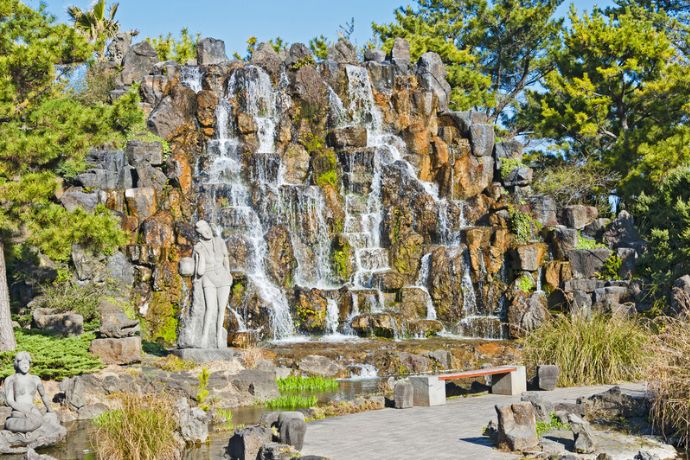
Aewol Coastal Road
Aewol Coastal Road is located a 10 minute drive west from Jeju City, and is a lovely 10km / 6.2 mi zig zag road which follows the northern coastline. The drive starts from Gamundong Port in Hagwi-ri and finishes in Aewol. Plan to take 1-2 hours to explore the route.

Arte Museum Jeju
The Arte Museum is a popular digital art museum with ten zones to explore. Projected moving images include aspects of nature or art, and combined with the accompanying soundtrack and other interactive elements is a great experience. Plan to take 1-2 hours to explore. Opening hours are from 10am – 8pm.
O’Sulloc Tea Museum & Innisfree Cafe
The O’Sulloc Tea Museum is located beside the O’Sulloc tea plantation to share the history of Korean tea and traditions through viewing a tea demonstration and tastings. The gift shop is a great option for purchasing some souvenirs and gifts. Plan to take 30 minutes to explore. Opening hours are from 9am – 6pm.
The Innisfree Jeju House is located beside O’Sulloc Tea Museum and is a great option to learn more about Innisfree cosmetics alongside enjoying their great organic Green Cafe food options. Plan to take 1 hour to explore and have a snack alongside some green tea. Opening hours are from 9am – 7pm in summer and from 9am – 6pm in winter.
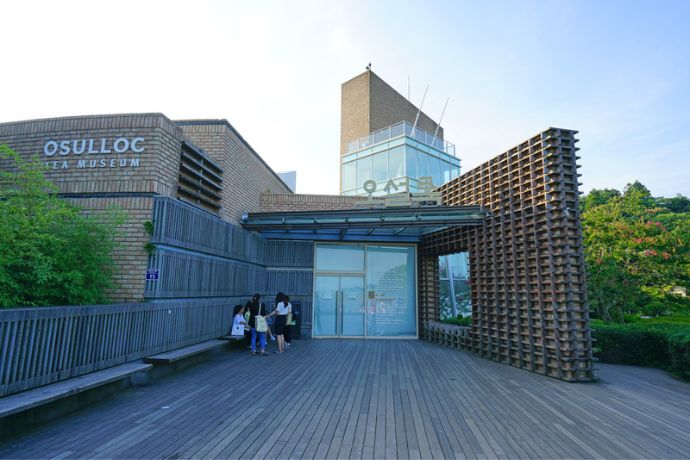
Camellia Hill Botanical Garden
Camellia Hill Botanical Garden is located inland from the south coast of Jeju Island, and is a very popular camellia arboretum with over 6,000 camellia trees from over 500 species on site as well as other plant displays, including a large glass house. The camellia flowers are in bloom from December to March, making this a great winter destination. Other seasons are also worthwhile to visit for the other plant displays, including hydrangeas and more. Plan to take 1-2 hours to explore. Opening hours are from 8.30am – 6pm, with extended hours to 6.30pm and 7pm over summer.
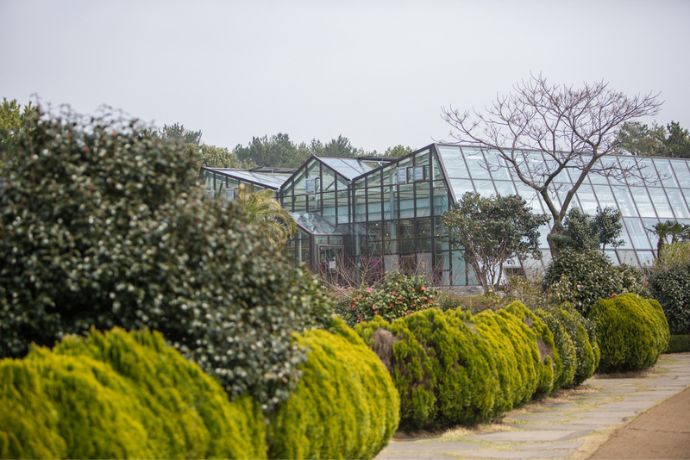
Hello Kitty Island
Hello Kitty Island is a great option for adults and kids alike to immerse themselves into the world of Hello Kitty. It is a great indoor attraction, with a museum with exhibits about the history of Hello Kitty, 18 other exhibits providing many selfie photo opportunities along with a children’s playground! The Hello Kitty Cafe is a great option for themed snacks and drinks. Plan to take 1-2 hours to explore. Opening hours are from 9am – 6pm.
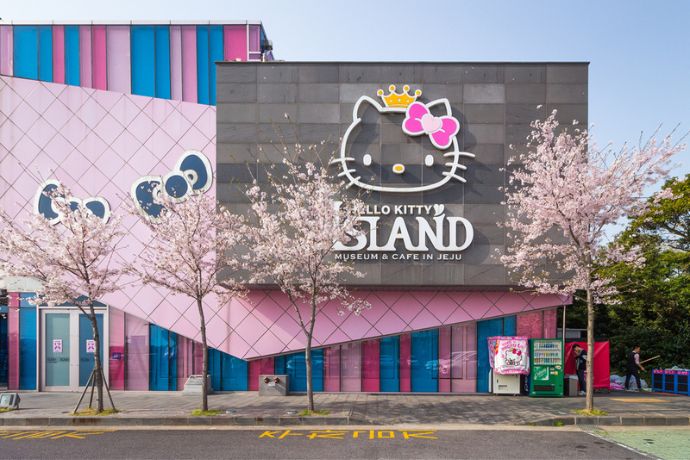
The Ma Park
The Ma Park is a horse themed park, with daily 50m horse riding performances held three times per day which display the legend of Jumong who created the Goguryeo Kingdom. Note that the performance is only in Korean. Onsite are also horse riding facilities for beginners through to advanced riders. Trazy offers discounted tickets to see the show, so click here to check out and book your tickets through Trazy.
World Automobile and Piano Museum
The World Automobile and Piano Museum is a great option for classic car enthusiasts, with an international collection of vehicles to explore, ranging from Model T Fords through to John Lennon’s custom Rolls Royce. There is also a great option for children (with a driving parent) to drive a fun small 2 seat electric car around the museum, and an animal petting zoo for the children.
Also on site is a large collection of 18th and 19th century pianos and harpsichords for music enthusiasts. Plan to take 1-2 hours to explore. Opening hours are from 9am – 6pm.
Jeju 4.3 Peace Park
The Jeju 4.3 Peace Park was constructed to remember between 14,000 and 30,000 civilian lives who died during the Jeju Uprising which started on 3 April 1948 (4.3.48), which continued to 1951. The Jeju Uprising and Massacre occurred at the end of World War II, following the end of the 35 year long Japanese occupation of Korea and the commencement of American military control of southern Korea. Jeju citizens protested against the division of Korea into the north and south.
The existence of the Jeju Uprising was censored for around 50 years, before the Korean government enabled public acknowledgement in the 1990s. In 2006 the Korean government issued a formal apology to the people of Jeju Island, and in 2019 Police officials also made a formal apology.
The Jeju 4.3 Peace Park was constructed as part of the reparation for the victims of the Jeju Uprising and was opened in 2008. The Memorial Hall contains details about this historic event. Outside is the Jeju 4.3 Peace Memorial, Memorial Service Altar, Memorial Tablets and Ashes, Tombstone Park for the Missing and sculptures. Plan to take approximately 2 hours to explore, and expect to be emotionally affected by your visit. Opening hours are from 9am – 6pm.
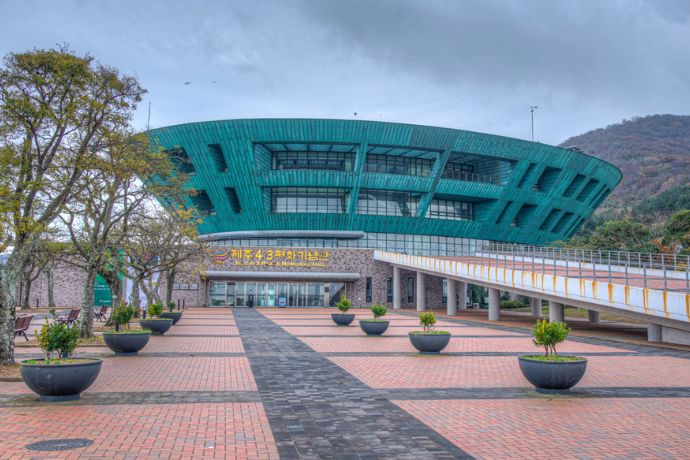
Spirited Garden
Spirited Garden is a relaxing bonsai garden which features hundreds of bonsai specimens. It is a great option to just relax and enjoy the garden. Plan to take approximately 1 hour to explore. Opening hours are from 8.30am – 6pm from November to March, and 8.30am – 6.30pm from April to October.
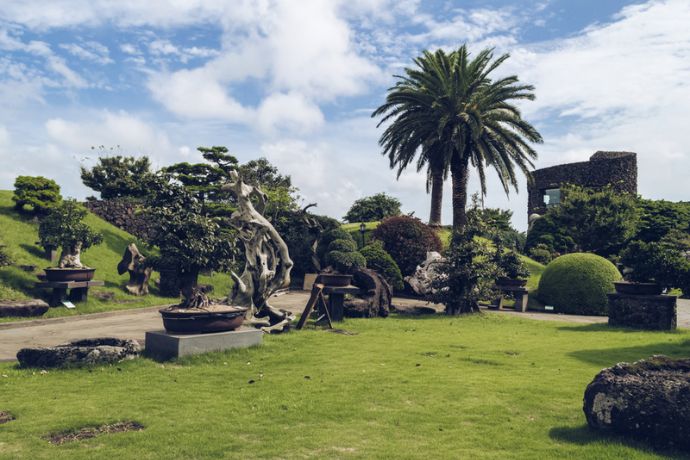
Jeju Glass Castle
Jeju Glass Castle is a lovely theme park for glass art. On site the indoor exhibition halls are set up with six themed areas, with over 250 glass sculptures on display. Outdoors there is the Magic Forest and other exhibits to explore. There is also an option to learn how to make your own glass art, with options for either lampworking, blowing or glass painting. Plan to take approximately 2 hours to explore. Opening hours are from 9am – 10pm from July and August, and 9am – 7pm for the remainder of the year.
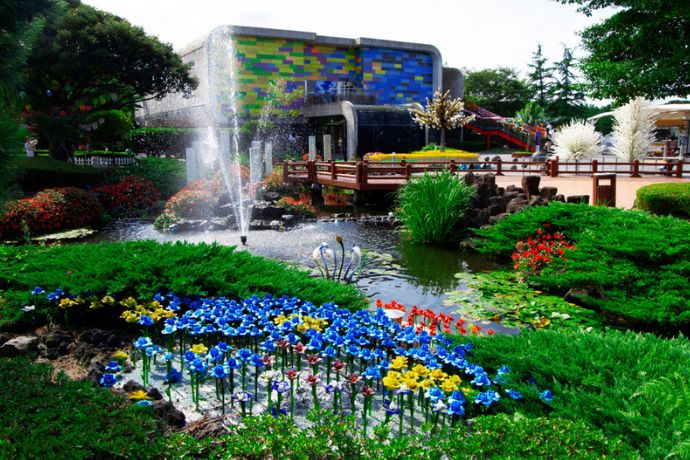
Jeju Aerospace Museum (JAM)
The Jeju Aerospace Museum is the largest aerospace museum in Asia and is a great option to learn more about the history of aviation, and in particular the history of the Korean Air Force and Korean space activities. There are both indoor and outdoor exhibits, with 26 aircraft on display. In addition, there are family friendly activities including interactive exhibits for kids, a kid’s play area and a flight simulator suitable for both adults and children (note minimum age requirements exist for some activities). Plan to take approximately 3-4 hours to explore. Opening hours are from 9am – 6pm, and it is closed on the third Monday of each month.
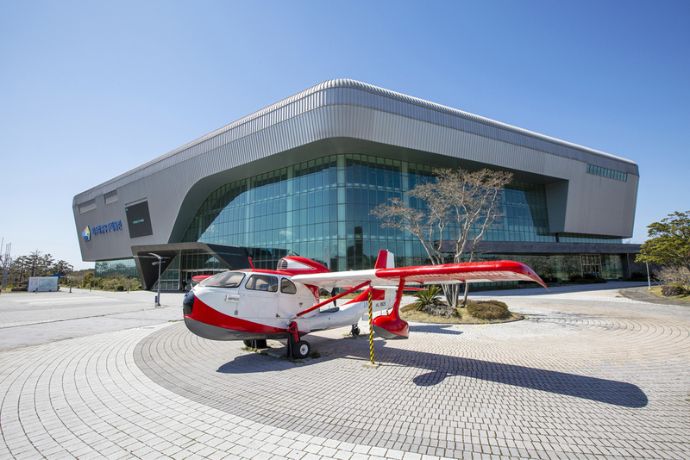
Suwolbong Peak and Chagwido Island
Suwolbong Peak is a 77m / 253 ft high volcanic oreum located on the most western point of Jeju Island where you can see amazing ocean views including Chagwido Island.
The Suwolbong Geo Trail consists of three walking routes, including around the mountain on the 3km / 1.9 mi / 1.5 hour long Course B, down the coastline to view the eroded stacked sandstone cliffs on the 4.6km / 2.9 mi / 2 hour long one way Course A and you can also catch the local ferry to Chagwido Island to walk the 4km / 2.5 mi / 1.5 hour long Course C. You can book your Chagwido Island ticket onsite.
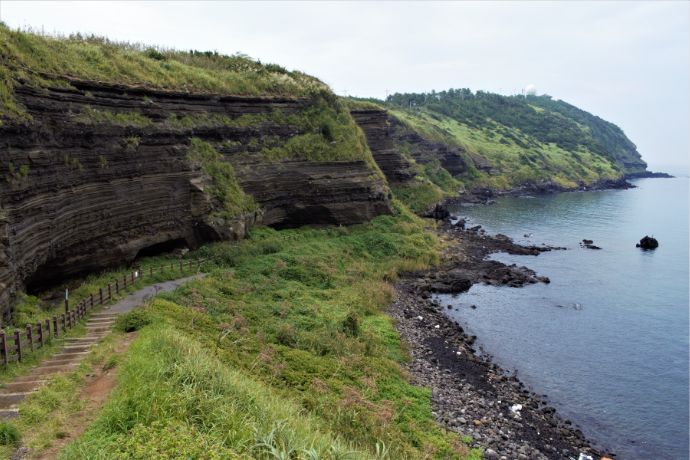
There is also a great option to go deep sea fishing near Chagwido Island which is available daily – note that you need to book at least 3 days prior. Click here to check out and book your deep sea fishing experience through Trazy.
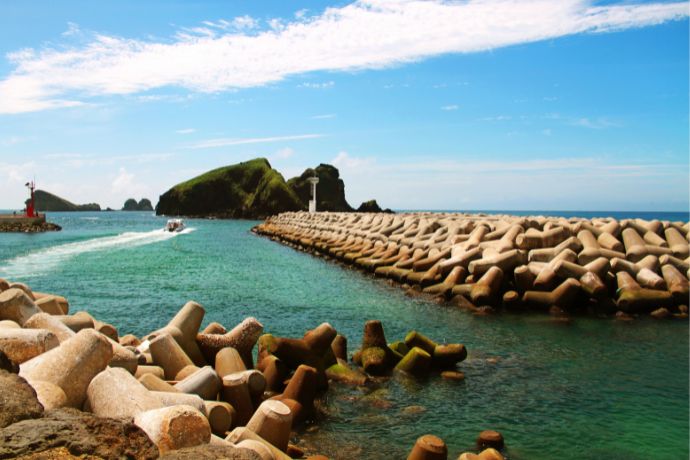
West Jeju Island Map
Below is a map showing the location of the major attractions on the western side of Jeju Island.
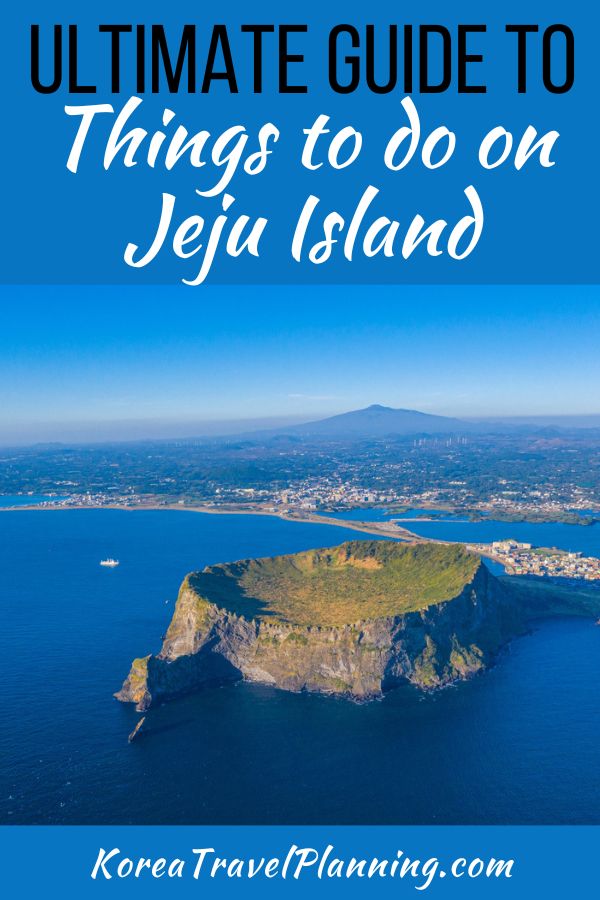
Join the South Korea Travel Planning Facebook Group
You are also welcome to join our South Korea Travel Planning Facebook Group – it is a great resource to enable you to ask questions about your upcoming trip to South Korea!
Disclaimer: This article contains affiliate links. If you book after clicking on one of these links then we may receive a small commission at no extra cost to you.
Anne Sutherland-Smith is a seasoned travel writer and a passionate explorer of South Korea’s vibrant culture, history, and landscapes. With decades of travel experience, Anne deeply understands what makes Korea a unique and captivating destination for travelers worldwide. As the lead author for koreatravelplanning.com, Anne’s work is based on thorough research and firsthand experiences. Her insights are regularly sought after in the travel community, and she has been featured in various travel forums and publications. Her expertise extends to Korean destinations, transportation, cuisine and the latest trends in Seoul’s bustling city life.
Dedicated to providing reliable and practical travel advice, Anne ensures that every piece of content on koreatravelplanning.com is accurate, up-to-date, and useful for travelers at every stage of their journey. Her commitment to authenticity and her personal experiences traveling across Korea make her a trusted voice in the travel community.
Follow Anne’s adventures and get valuable Korea travel tips on koreatravelplanning.com and through her social media channels. Whether you’re planning your first trip to Korea or looking to explore deeper, Anne’s insights will be your invaluable guide.


